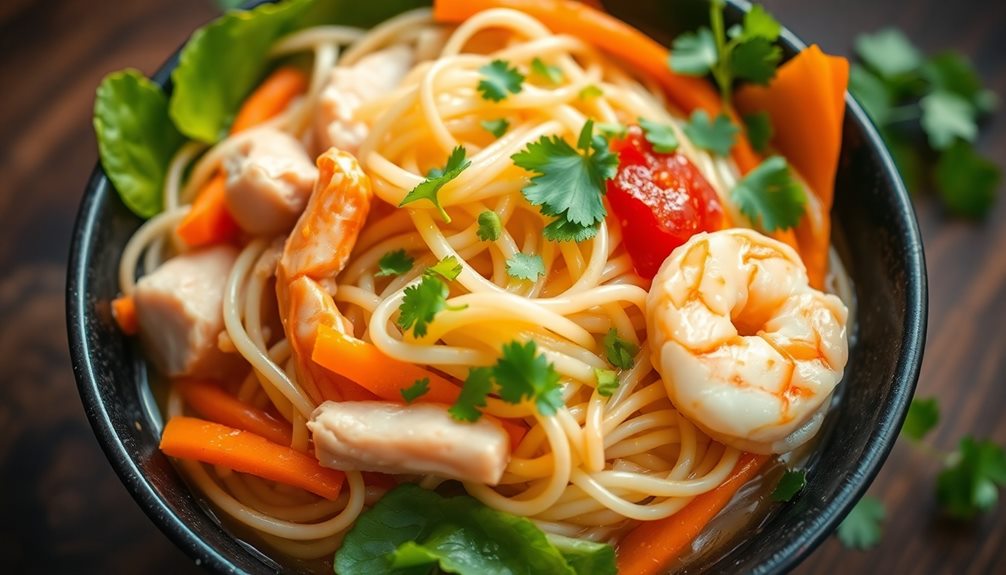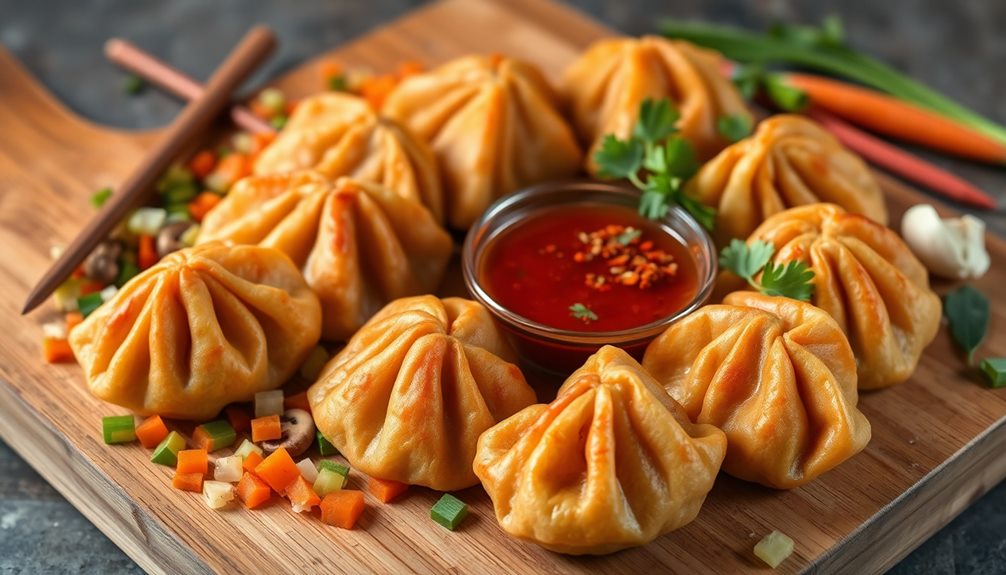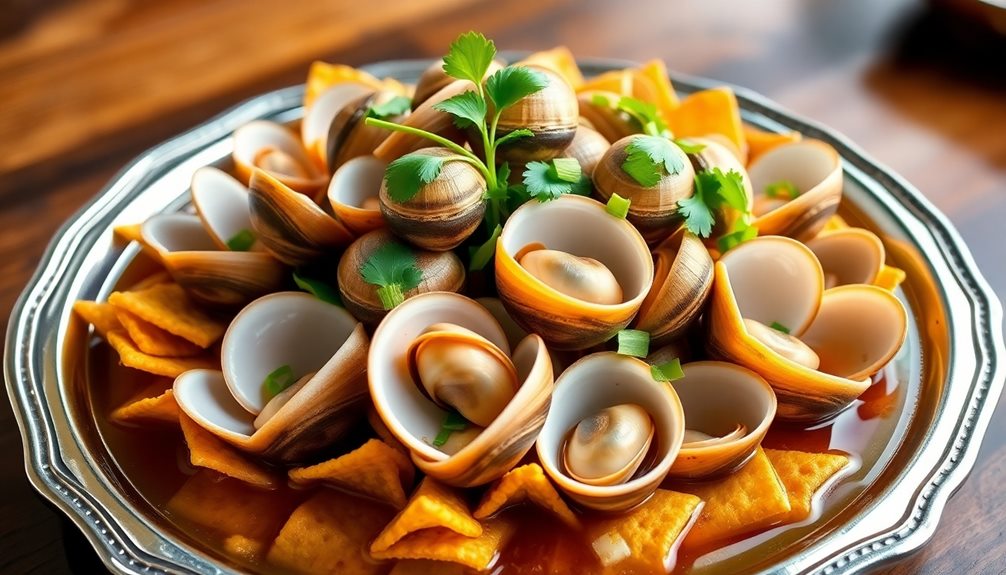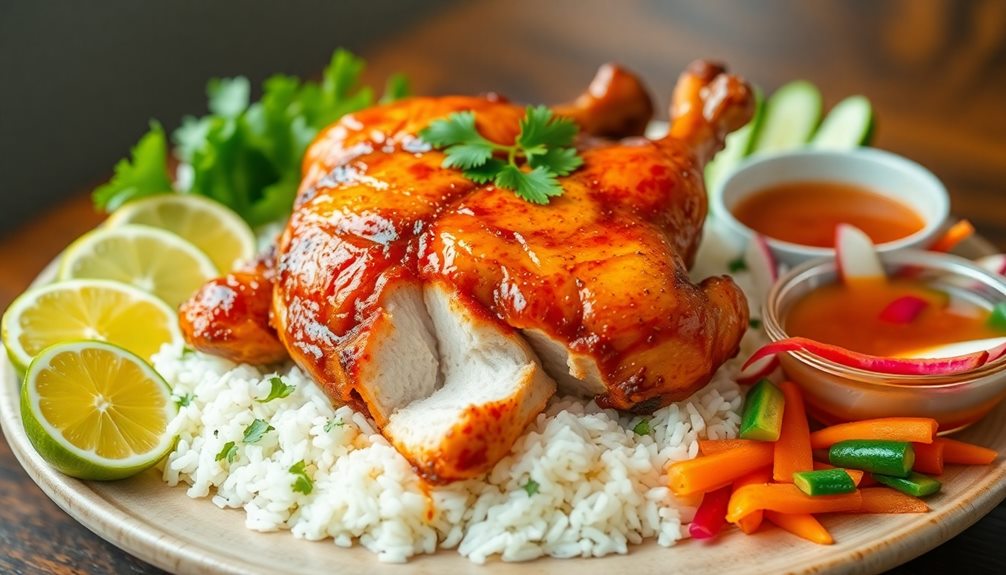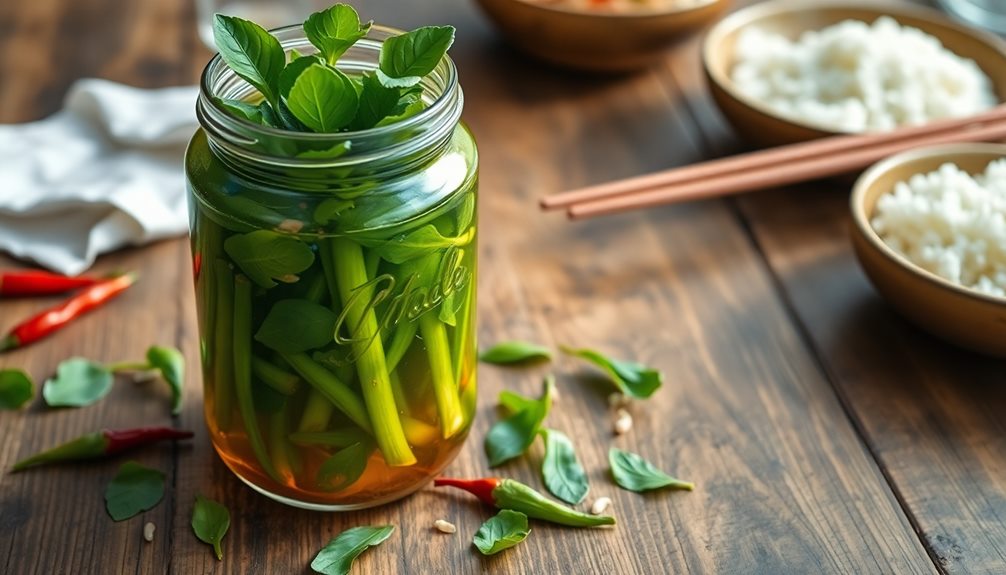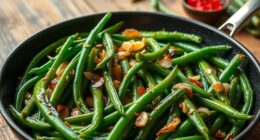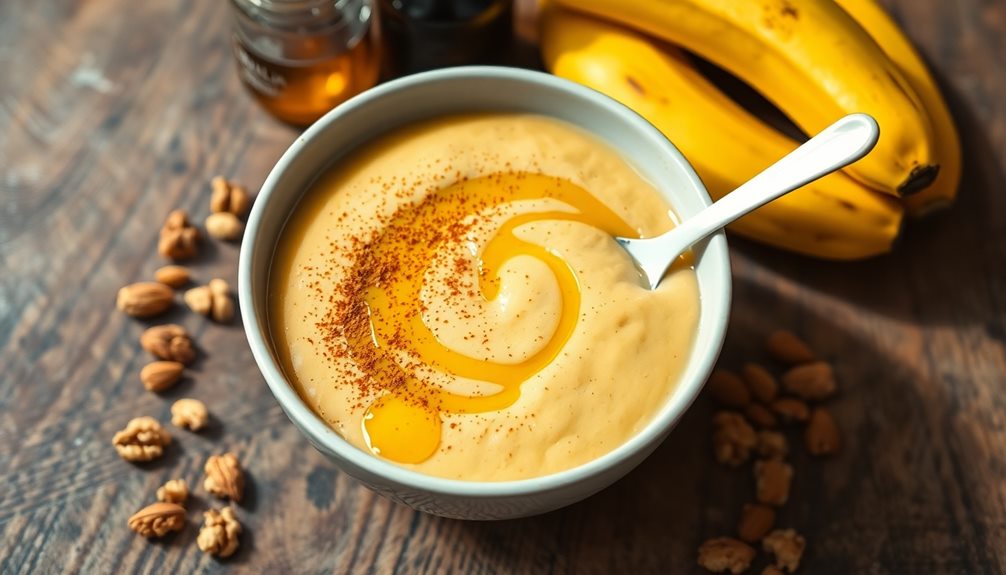Mien noodles, the delicate and translucent Vietnamese clear noodle, offer a delightful culinary journey. Tracing their origins to China, these noodles have become an integral part of Vietnamese cuisine. Made from mung bean starch, they boast a unique texture that absorbs flavors beautifully. To prepare, you'll soak the dried noodles in hot water, then drain and rinse them before stir-frying with veggies and proteins. The addition of fragrant herbs like mint and cilantro provides the final touch, creating a symphony of tastes. Mien noodles are a true celebration of Vietnam's rich culinary heritage – and there's more to discover about this captivating dish.
Key Takeaways
- Mien noodles, made from mung bean starch, are a delicate and translucent staple in Vietnamese cuisine with a long-standing history.
- The unique texture and flavor absorption of mien noodles elevate the overall dining experience, making them a versatile ingredient for various Vietnamese dishes.
- Soaking and rinsing the noodles properly are crucial steps to achieve the desired softness and prevent excess starchiness.
- Stir-frying mien noodles with vegetables and proteins like chicken allows the noodles to absorb the flavors, creating a harmonious and satisfying dish.
- Garnishing the dish with fresh herbs like mint, cilantro, and Thai basil adds fragrance and a signature Vietnamese flair to the mien noodle experience.
History

Although the exact origins of Mien noodles are unclear, they've been a staple in Vietnamese cuisine for centuries. These delicate, translucent noodles are made from mung bean starch and have a long and fascinating history.
Mien noodles likely originated in China, where they've been enjoyed for generations. Over time, the recipe and preparation techniques made their way to Vietnam, where they were adapted to local flavors and ingredients.
Today, Mien noodles are a beloved part of Vietnamese culinary tradition, appearing in a variety of dishes across the country.
What makes Mien noodles so special is their unique texture and ability to soak up the flavors of the ingredients they're cooked with. Whether served in a savory broth or stir-fried with vegetables and proteins, these delicate noodles always deliver a satisfying and delicious experience.
Discover the history and allure of Mien noodles, a true taste of Vietnam.
Cooking Steps

To begin the cooking process, gather all the necessary ingredients and prepare your workstation. You'll need mien noodles, chicken or vegetable broth, fish sauce, sugar, lime juice, and your choice of vegetables and proteins.
Start by soaking the mien noodles in hot water for 15-20 minutes until they're softened. Drain and set them aside.
In a large pot, bring the broth to a simmer. Add the fish sauce, sugar, and a squeeze of lime juice. Taste and adjust the seasoning as needed.
Next, add your choice of vegetables, such as sliced mushrooms, carrots, and cabbage. Let them cook for a few minutes until tender.
Finally, add the soaked mien noodles and any cooked proteins, like shredded chicken or sautéed tofu. Gently toss everything together and serve hot, garnished with fresh herbs and a sprinkle of lime juice.
Enjoy your authentic Vietnamese clear noodle dish!
Step 1. Soak Dried Mien Noodles in Hot Water

Gathering the dried mien noodles, you'll need to submerge them in piping-hot water for a brief spell. This crucial step helps the noodles soften and become pliable, ready to soak up all the delicious flavors in your Vietnamese dish.
Simply pour boiling water over the noodles, ensuring they're fully submerged. Let them sit for 5-7 minutes, gently stirring occasionally to encourage even soaking.
You'll know they're ready when the noodles have become translucent and slippery to the touch.
Drain the noodles well, giving them a gentle squeeze to remove any excess moisture. This step sets the stage for the next part of your mien noodle preparation, where you'll combine the noodles with flavorful broth and your choice of fresh vegetables and proteins.
Get ready for a burst of Vietnamese goodness!
Step 2. Drain and Rinse Noodles

Once the noodles have soaked, go ahead and drain them into a colander.
Give the noodles a gentle rinse under cool running water. This will help remove any excess starch and prevent them from sticking together. Be sure to give the colander a few shakes to allow the water to drain off completely.
Now that your noodles are nice and clean, you're ready for the next step.
Grab a pair of tongs and give the noodles a gentle toss to separate them. This will ensure each strand is coated evenly with the flavors you'll be adding later. Don't worry if the noodles look a little tangled – you can easily untangle them as you go.
With the noodles drained and rinsed, you're one step closer to enjoying a delicious Vietnamese clear noodle dish.
The next part is where the real magic happens, so get ready to add some amazing flavors to your mien!
Step 3. Stir-Fry Noodles With Vegetables

With your noodles ready, grab a large skillet or wok and heat it over medium-high heat.
Once it's nice and hot, add a tablespoon of oil and let it shimmer. Toss in your veggies – maybe some sliced carrots, crunchy bean sprouts, and tender spinach leaves. You could also consider adding some spiced potatoes for an extra kick, reminiscent of a popular snack in Indian cuisine.
Stir-fry them for a minute or two until they start to soften.
Now it's time to add the star of the show – your mien noodles! Carefully lower them into the skillet and use your tongs to gently separate the strands.
Let them sizzle and absorb all those delicious flavors. Give everything a good stir, making sure the noodles don't stick together.
As the noodles cook, drizzle in a splash of soy sauce and a pinch of sugar. This will create a savory-sweet balance that's oh-so-tasty. As the noodles soften and absorb the flavors, toss in some fresh veggies or a handful of cooked protein to make the dish more filling. For an extra layer of flavor, consider adding a dash of sesame oil or a sprinkle of crushed chili flakes. If you’ve ever wondered about ramen vs ramyun differences, this is a great opportunity to experiment, as subtle tweaks to broth, spice levels, and textures can highlight the unique characteristics of each dish.
Keep stirring and tossing until the noodles are heated through and the veggies are crisp-tender. Now it's ready to serve!
Grab your bowls and dive in to enjoy this flavor-packed Vietnamese delight.
Step 4. Add Chicken

If you'd like to add some chicken to your mien noodle dish, start by thinly slicing 1-2 boneless, skinless chicken breasts.
Heat a large skillet or wok over medium-high heat and drizzle in a bit of oil. Once the oil is hot, add the sliced chicken and stir-fry until it's cooked through, about 5-7 minutes. The chicken should be lightly browned and no longer pink in the center.
Next, add your cooked mien noodles to the skillet, along with the soy sauce, fish sauce, and any other desired seasonings.
Toss everything together until the noodles are well-coated and heated through. If the mixture seems dry, you can add a splash of broth or water to keep it nice and saucy.
Step 5. Garnish With Fresh Herbs

To finish off your mien noodle dish, don't forget to add some fresh herbs for extra flavor and color. Herbs like mint, cilantro, and Thai basil are commonly used in Vietnamese cooking and will really make your noodles pop.
Tear the leaves into bite-sized pieces and scatter them generously over the top of your bowl. The cool, aromatic herbs will provide a refreshing contrast to the warm, slippery noodles. Plus, the vibrant green hues will make your dish look absolutely stunning.
Don't be shy – load it up with as many herbs as you like! The more the better, we say. The herbs will add a lovely fragrance and that signature Vietnamese flair.
With the tender chicken, flavorful broth, and now these fresh herbs, your mien noodles are complete. Dig in and enjoy the perfect balance of textures and tastes in every bite.
Final Thoughts

Ultimately, Mien noodles offer a delightful and authentic taste of Vietnamese culinary traditions.
These crystal-clear noodles aren't only visually stunning but also incredibly versatile. Whether you enjoy them in a hearty soup or as a refreshing salad, Mien noodles never fail to impress. Their unique texture and delicate flavor profile make them a true delight for the senses.
As you savor each bite, you'll be transported to the vibrant streets of Vietnam, where these noodles are a beloved staple. The combination of tender noodles, fragrant herbs, and a flavorful broth or dressing creates a symphony of tastes that will leave you craving more.
Mien noodles are the perfect choice for those seeking a light, yet satisfying meal that celebrates the rich culinary heritage of Vietnam.
Frequently Asked Questions
Where Can I Find the Ingredients for Mien Noodles?
You can find the ingredients for mien noodles at your local Asian grocery store or online specialty retailers. They usually carry the specific vermicelli-like noodles as well as the other required ingredients like fish sauce and herbs.
How Long Do Mien Noodles Typically Take to Prepare?
Preparing mien noodles typically doesn't take too long. You can usually get them ready in under 30 minutes, from boiling the noodles to assembling the dish. The quick cooking time makes it a convenient and easy-to-prepare meal.
Can Mien Noodles Be Frozen or Stored for Later Use?
You can absolutely freeze or store mien noodles for later use. They'll keep well in the freezer for up to 3 months. Just be sure to thaw them in the fridge before reheating and using in your favorite recipes.
Are There Any Variations or Regional Differences in Mien Noodles?
There are regional variations in mien noodles across Vietnam. Depending on the province, you'll find differences in the noodle thickness, texture, and even the soup or dipping sauce accompaniments. The versatility of mien makes it a beloved staple throughout the country.
What Are Some Common Serving Suggestions for Mien Noodles?
You can serve mien noodles in a variety of ways. Top them with grilled meats, sautéed vegetables, or even a savory broth. They also pair well with fresh herbs, bean sprouts, and a squeeze of lime juice.
